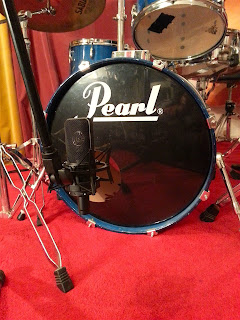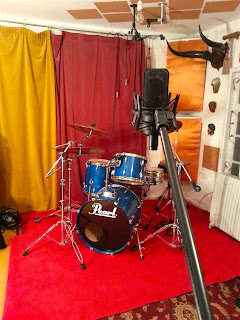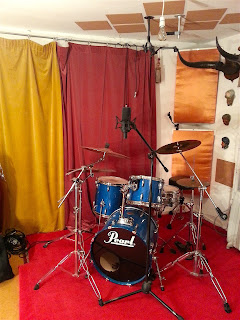Recording Drums 4 - Compressing Room Mics !
Recording Drums, Percussion - & Dealing with People Who Like to Hit Things 4
Here at The Coolest Recording Studio in London Town - we got All Kindsa flavours - old valve mic preamps for a rich & pretty tone to modern broadcast preamps that capture every whisper with clarity and definition - plus a whole plethora! of different mics - ribbons - dynamics - condensers & tube.However - sometimes - especially when capturing drums & percussion - you need a little extra something to throw into the mix pot - & this is where compressing room mics comes in.
We use this setup to add a natural ambience to the recording - & a shedload of energy!
If you don't know about compression - read about it HERE - it is - along with eq - the most important audio shaping tool in any studio - you need to work with it ..... a lot - to understand it - we'll go into all that later - here's a pic of a regular averagely priced compressor:
For now, we're going to leave the settings (knobs) where they are - & just attenuate the gain & output volume.
But first:
Ambient mic compression setups for Drums:
1. Putting a large diaphragm (LDC) condenser mic in front (approx 16 inches to 2 feet) from the kick drum - running that into a mic preamp - & the preamp into a compressor will generally give you two things depending on how you set up the compressor. If you leave the attack knob where it is (12 o'clock) & turn the release knob fully left - you'll get a banging kick sound - & a ton of energy from the whole kit - if you then turn the attack full left - you'll get the same but with a much more controlled kick. Turn the release knob right - & you'll get decreasing energy - but a much more controlled audio picture.
Experiment - & mix this audio track in with the close mics.
2. Put an ldc mic approx 8 feet away from the kit facing the snare drum - adjust height to taste (higher more ambience & top end - lower more kit & drums) - run through a compressor & tweak to taste - try to imagine how you want the kit to sound in relation to all the other instruments along the timeline of the track. You may want less energy in the verse & more in the chorus - so set / ride the attack & release knobs as needed.
3. Put an ldc mic in front & facing away from the kit, usually between the top of the kick drum to just above the cymbals - set the mic to cardioid (directional) if you have the option - run it through a compressor & play with the attack & release until the desired energy is achieved.
The Window Mic!
4. Put an ldc mic facing a reflective surface in the live room - this will give you some nice, natural ambient reflections of the kit you're recording - it's an old trick - but one that works every time - run it through a compressor for an extra bit of juice!
All these microphone techniques.
All these microphone techniques are a way to get your kit to sit naturally in the mix - hopefully without having to resort to reverb or other time delay effects - you're trying to capture the natural ambience of the instrument - in the ambient space it was recorded in.Think on that & what it means.






Comments
Post a Comment